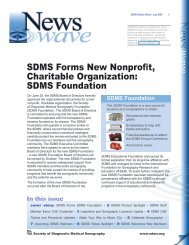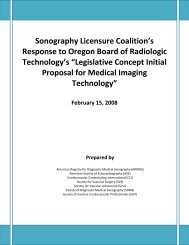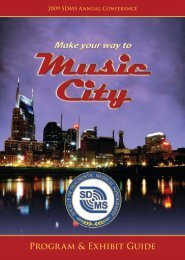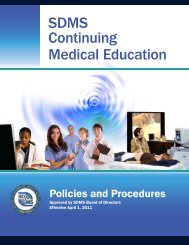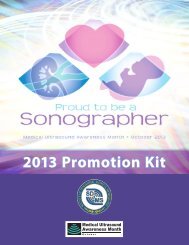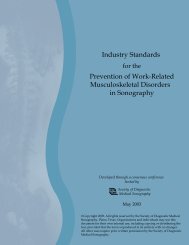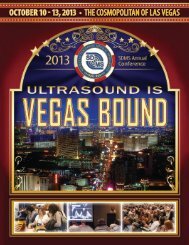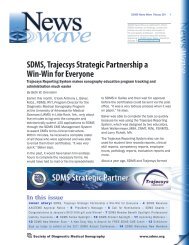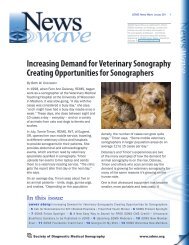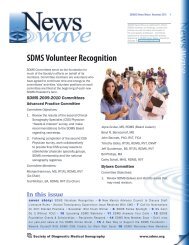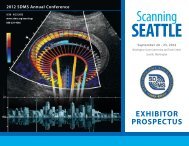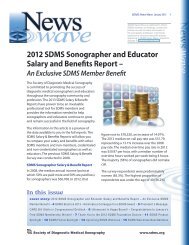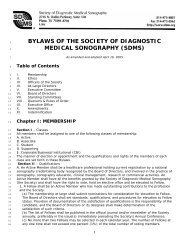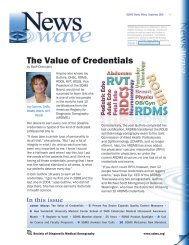The Ultrasound Practitioner - Society of Diagnostic Medical ...
The Ultrasound Practitioner - Society of Diagnostic Medical ...
The Ultrasound Practitioner - Society of Diagnostic Medical ...
You also want an ePaper? Increase the reach of your titles
YUMPU automatically turns print PDFs into web optimized ePapers that Google loves.
<strong>The</strong> <strong>Ultrasound</strong> <strong>Practitioner</strong><br />
A Proposal<br />
Response to the SDMS for the Development <strong>of</strong> A<br />
Middle Care Provider in <strong>Ultrasound</strong> Imaging<br />
<strong>Ultrasound</strong> <strong>Practitioner</strong> Commission<br />
Carolyn C<strong>of</strong>fin, BS, RDMS, RVT<br />
Dale Cyr, MBA, RDMS, RDCS<br />
Rebecca Hall, PHD, RDMS (Chair)<br />
Wayne Persutte, BS, RDMS<br />
Doug Roberts, BS, RDMS, RDCS<br />
Jean Lea Spitz, MPH, RDCS, RDMS<br />
Alan Waggoner, MS, RDCS<br />
Supported by:<br />
<strong>The</strong> <strong>Society</strong> <strong>of</strong> <strong>Diagnostic</strong> <strong>Medical</strong> Sonographers<br />
2745 N Dallas Pkwy<br />
Suite 350<br />
Plano, Texas 75093-4706
Table <strong>of</strong> Contents<br />
1. INTRODUCTION 3<br />
THE CHANGING MILIEU OF MEDICINE 3<br />
THE TRADITIONAL ROLE OF THE SONOGRAPHER 3<br />
PROBLEMS WITH THE CURRENT MODEL OF PRACTICE 4<br />
THE ULTRASOUND PRACTITIONER 6<br />
MODELS OF NONPHYSICIAN MEDICAL PRACTICE 8<br />
2. WHY THE ULTRASOUND PRACTITIONER 10<br />
INCREASING NEED FOR ULTRASOUND-RELATED HEALTH CARE IN THE UNITED STATES 10<br />
INCREASING NEED FOR SERVICES IN THE GLOBAL MARKETPLACE 11<br />
INCREASING NEED FOR MORE ECONOMIC HEALTH CARE 12<br />
INCREASING NEED FOR PHYSICIAN SERVICES 12<br />
DECREASING PATIENT CARE COSTS 13<br />
3. EFFECTIVENESS OF NONPHYSICIAN PRACTITIONER SERVICES 14<br />
HISTORICAL 14<br />
ULTRASOUND DIAGNOSIS AND THE NONPHYSICIAN CLINICIAN 15<br />
COMPETENCE OF ULTRASOUND SERVICES 16<br />
ANTICIPATED PROBLEMS WITH ULTRASOUND PRACTITIONER PRACTICE 16<br />
4. EDUCATIONAL STANDARDS FOR THE ULTRASOUND PRACTITIONER 18<br />
BACKGROUND 18<br />
DEFINITION 19<br />
EDUCATIONAL REQUIREMENTS 19<br />
STANDARDS OF ULTRASOUND PRACTITIONER MASTER DEGREE 20<br />
NATIONAL BOARD CERTIFICATION 22<br />
CONTINUING MEDICAL EDUCATION 22<br />
EDUCATIONAL DEVELOPMENT 23<br />
5. LEGAL IMPLICATIONS OF THE ULTRASOUND PRACTITIONER 25<br />
MEDICOLEGAL LIABILITY FOR MEDICAL PRACTITIONERS 25<br />
FAILURE TO DIAGNOSE 27<br />
ACCOUNTABILITY 27<br />
STANDARD OF CARE 28<br />
CREDENTIALS/LICENSURE 28<br />
- 2 -
Chapter<br />
1<br />
Introduction<br />
<strong>The</strong> Changing Milieu <strong>of</strong> Medicine<br />
<strong>The</strong> societal need for change in the domestic healthcare system has been<br />
debated and documented. <strong>The</strong> debate has created dynamic tensions<br />
between cost accountability and traditional unlimited access to care<br />
between primary and specialized clinicians, between acute treatment and<br />
managed care and prevention, and between individual physician and team<br />
providers. 1 Patients, providers, and payers are continuously seeking<br />
alternatives that provide quality, community, and patient-centered care.<br />
<strong>Medical</strong> technology increased knowledge, and interventions have created<br />
the need for highly specialized health care personnel other than doctors,<br />
nurses, pharmacists, and dentists. <strong>The</strong>se groups <strong>of</strong> personnel known<br />
collectively as “allied health providers” are now estimated to comprise 60%<br />
<strong>of</strong> the health care workforce worldwide. 2 In the United States, Allied<br />
Health is one <strong>of</strong> the fastest growing occupational groups as evidenced by<br />
a 144% growth rate from 1970-1990. 3 Change within these allied health<br />
groups parallel those in other segments and will include increased<br />
responsibility for patient management, increased need and opportunity for<br />
critical thinking and decision making, and increased involvement on<br />
healthcare teams. 4<br />
<strong>The</strong> Traditional Role <strong>of</strong> the Sonographer<br />
Practice <strong>of</strong> <strong>Ultrasound</strong><br />
<strong>The</strong> art and science <strong>of</strong> ultrasonography has been practiced in the United<br />
States for more than thirty years. Traditionally, clinical ultrasonographic<br />
examinations have been performed collaboratively by both physicians, or<br />
sonologists, and non-physicians, or sonographers. <strong>The</strong> technical<br />
component <strong>of</strong> the examination (production <strong>of</strong> images) has been<br />
considered the responsibility <strong>of</strong> the sonographer and the pr<strong>of</strong>essional<br />
component (interpretation <strong>of</strong> the images) has been the purview <strong>of</strong> the<br />
sonologist. Some argue that the interpretation <strong>of</strong> the ultrasound image is<br />
the practice <strong>of</strong> medicine. <strong>The</strong> American Institute <strong>of</strong> <strong>Ultrasound</strong> in Medicine<br />
(AIUM) has affirmed:<br />
“<strong>Ultrasound</strong> studies shall be supervised and interpreted by a physician with training and experience in<br />
the specific area <strong>of</strong> ultrasonography. Findings must be recorded and results communicated in a timely<br />
- 3 -
fashion to the physician responsible for care. Although a sonographer may play a critical role in<br />
extracting the information essential to deriving a diagnosis, the rendering <strong>of</strong> a final diagnosis <strong>of</strong><br />
ultrasound studies represents the practice <strong>of</strong> medicine, and, therefore, is the responsibility <strong>of</strong> the<br />
supervising physician. 5 ”<br />
<strong>The</strong> Sonographer<br />
According to the <strong>Society</strong> <strong>of</strong> <strong>Diagnostic</strong> <strong>Medical</strong> Sonographers, the<br />
sonographer 6 :<br />
“. . .utilizes high frequency sound waves and other diagnostic techniques for medical diagnosis. <strong>The</strong><br />
pr<strong>of</strong>essional level <strong>of</strong> this health care service requires highly skilled and competent individuals who<br />
function as integral members <strong>of</strong> the health care team. <strong>The</strong> <strong>Diagnostic</strong> Sonographer must be able to<br />
produce and evaluate ultrasound images and related data that are used by physicians to render a<br />
medical diagnosis. <strong>The</strong> <strong>Diagnostic</strong> Sonographer must acquire and maintain specialized technical skills<br />
and medical knowledge to render quality patient care.”<br />
<strong>The</strong> number <strong>of</strong> health pr<strong>of</strong>essionals who specialize in ultrasound has<br />
increased exponentially since the 1970's. Currently there are over 34,000<br />
sonographers and vascular technologists registered in at least one <strong>of</strong> eight<br />
specialty examinations by the American Registry <strong>of</strong> <strong>Diagnostic</strong> <strong>Medical</strong><br />
Sonographers (ARDMS). 7 <strong>The</strong>se registrants represent a minority <strong>of</strong> the<br />
healthcare personnel actually performing ultrasound examinations.<br />
Education, experience, and expertise within the groups <strong>of</strong> non-physician<br />
and physician health pr<strong>of</strong>essionals practicing sonography vary widely.<br />
<strong>The</strong> need for ultrasound imaging pr<strong>of</strong>essionals with standardized<br />
education and enhanced expertise to apply this technology to patients in a<br />
cost-effective and quality manner is essential.<br />
Problems with the Current Model <strong>of</strong> Practice 10<br />
<strong>The</strong> <strong>Diagnostic</strong> <strong>Medical</strong> Sonographer or sonographer is the health care<br />
pr<strong>of</strong>essional responsible for the administration <strong>of</strong> the diagnostic<br />
ultrasonographic examination. In 1970 when the pr<strong>of</strong>ession was founded,<br />
the role <strong>of</strong> the Sonographer (then known as the <strong>Ultrasound</strong> Technical<br />
Specialist) in health care was envisioned to be exclusively technical.<br />
Generally, the sonographer exercised limited judgement in diagnosis and<br />
patient assessment. <strong>The</strong> relationship between the sonographer and<br />
physician required that both partners be educated, well trained, and<br />
experienced.<br />
As ultrasound became an accepted medical procedure, the lack <strong>of</strong><br />
physician training and development in the field became significant<br />
problem. Over the course <strong>of</strong> time, it became obvious that sonography was<br />
highly operator-dependent, and the talent and experience required to<br />
interpret sonographic images by the physician was underestimated. Many<br />
- 4 -
incorrectly assumed physicians could easily acquire the skill within the<br />
limited duration <strong>of</strong> their medical education. This was not to be the case.<br />
In the 1970’s and 1980’s, as the deficiencies in physician training became<br />
apparent, the role <strong>of</strong> the well-trained and experienced sonographer<br />
expanded. Because <strong>of</strong> the daily analysis <strong>of</strong> hundreds <strong>of</strong> sonographic<br />
images by many sonographers and the close working relationship with<br />
subspecialist physicians, their expertise grew in the acquisition and<br />
interpretation <strong>of</strong> these images. <strong>The</strong>se sonographers developed keen<br />
interpretive skills that were relied upon by physicians. Chan et. al. stated,<br />
“<strong>The</strong> functional level <strong>of</strong> sonographers will vary with their natural talents,<br />
their levels <strong>of</strong> training, and experience, and their ability to integrate their<br />
sonographic experiences on the job.” 8 Indeed, many physicians with less<br />
time devoted to obtaining the skills necessary to analyze the image<br />
became dependent on what the sonographer “could see” and the<br />
sonographer’s description <strong>of</strong> both normal and abnormal anatomy. This<br />
“non-classical” approach to sonographic interpretation, not historically<br />
envisioned early on, is now common practice in the United States.<br />
In the past thirty years, a variety <strong>of</strong> problems are known with the current<br />
system <strong>of</strong> clinical practice. While this system is not inherently flawed and it<br />
functions well in many regions <strong>of</strong> the United States, a variety <strong>of</strong> problems<br />
are known to exist. <strong>The</strong>se include, but are not limited to:<br />
• Logistic limitations - <strong>The</strong> number <strong>of</strong> patients that can be examined on a<br />
daily basis is limited. Large blocks <strong>of</strong> time are required for sonograms<br />
to be reviewed, and sometimes reexamined by a physician.<br />
• Latency <strong>of</strong> interpretation - <strong>The</strong> final interpretation, for even emergency<br />
examinations, <strong>of</strong>ten occurs long after the examination has been<br />
performed. Thus, the referring clinician does not obtain the diagnosis in<br />
a timely manner. <strong>The</strong> physical distance between sonographer and<br />
interpreting physician may contribute to this problem.<br />
• Deficiencies in physician ultrasound training – Many sonographers<br />
may have more experience and better interpretation skills than their<br />
physician counterparts. Sonographers have, through continuing<br />
medical education, adapted to new technologies. Physician<br />
supervision and interpretation, while an ideal and theoretical goal, may<br />
not be universally achievable.<br />
• Advanced Sonographer Training and Experience - <strong>The</strong> clinical<br />
demands and diversity <strong>of</strong> ultrasound practice have fostered an<br />
evolution <strong>of</strong> sonographers practicing beyond the scope <strong>of</strong> the<br />
traditional definition. Some sonographers have achieved both a<br />
medical and technical understanding equivalent to that <strong>of</strong> a physician,<br />
nurse practitioner, or physician’s assistant. Many sonographers<br />
- 5 -
currently both supervise clinical ultrasonography and interpret<br />
ultrasonography studies. 9 Depending on the application <strong>of</strong><br />
ultrasonography, diagnosis and the rendering <strong>of</strong> a final report by the<br />
non-physician has become commonplace. Unfortunately, no advanced<br />
standards <strong>of</strong> training or practice exist to define this type <strong>of</strong> practice.<br />
This has resulted in the somewhat ill defined, but nonetheless widely<br />
accepted advanced practice <strong>of</strong> sonography by the sonographer.<br />
<strong>The</strong> Commission is concerned that real-life circumstances have led to<br />
conditions in which many sonographers are functioning beyond their<br />
defined Scope <strong>of</strong> Practice. Common sonographic practices may put the<br />
public at risk because <strong>of</strong> the lack <strong>of</strong> both standards <strong>of</strong> practice and<br />
standards <strong>of</strong> education. We believe that these issues must be clarified and<br />
a structure <strong>of</strong> accountability established. It is with that intent that we<br />
propose the new pr<strong>of</strong>ession <strong>of</strong> the <strong>Ultrasound</strong> <strong>Practitioner</strong>.<br />
<strong>The</strong> <strong>Ultrasound</strong> <strong>Practitioner</strong><br />
First suggested in 1993 as the Advanced Practice Sonographer 10 , the<br />
current document has been constructed to propose formally the pr<strong>of</strong>ession<br />
<strong>of</strong> <strong>Ultrasound</strong> <strong>Practitioner</strong>. In 1996, a Task Force commissioned by the<br />
Board <strong>of</strong> Directors <strong>of</strong> the <strong>Society</strong> <strong>of</strong> <strong>Diagnostic</strong> <strong>Medical</strong> Sonographers was<br />
charged with investigating the feasibility <strong>of</strong> this type <strong>of</strong> practitioner. In 1998,<br />
the <strong>Ultrasound</strong> <strong>Practitioner</strong> Commission was established to develop<br />
this pr<strong>of</strong>ession.<br />
<strong>The</strong> <strong>Ultrasound</strong> <strong>Practitioner</strong> Commission defines the <strong>Ultrasound</strong><br />
<strong>Practitioner</strong> as:<br />
Definition<br />
<strong>The</strong> <strong>Ultrasound</strong> <strong>Practitioner</strong> is a health care pr<strong>of</strong>essional who autonomously performs and interprets<br />
ultrasound procedures in primary or specialty care settings. As part <strong>of</strong> the interdisciplinary team, the<br />
<strong>Ultrasound</strong> <strong>Practitioner</strong> will provide services based upon clinical competency obtained by advanced<br />
education and clinical experience.<br />
<strong>The</strong> <strong>Ultrasound</strong> <strong>Practitioner</strong> will function as part <strong>of</strong> a healthcare team with<br />
primary responsibility to manage or perform ultrasound examinations.<br />
This pr<strong>of</strong>essional will assess and use critical thinking to contribute to<br />
clinical decisions based on the ultrasound results and other primary<br />
assessments. <strong>The</strong> <strong>Ultrasound</strong> <strong>Practitioner</strong> may function within radiology,<br />
obstetrics, urology, cardiology, vascular surgery and/or other specialty and<br />
primary care areas. <strong>The</strong> <strong>Ultrasound</strong> <strong>Practitioner</strong> will work within a<br />
healthcare team and in association with a primary care provider or<br />
specialty physician. As computer networking and telemedicine evolves, it<br />
is likely that some <strong>Ultrasound</strong> <strong>Practitioner</strong>s may function at a distant<br />
- 6 -
location. <strong>The</strong> <strong>Ultrasound</strong> <strong>Practitioner</strong> will be capable <strong>of</strong> clinical<br />
assessment, patient counseling, and cost-effective patient referrals as well<br />
as primary ultrasound imaging assessment. <strong>The</strong> <strong>Ultrasound</strong> <strong>Practitioner</strong><br />
may also be a contact for patients in some team care situations.<br />
<strong>The</strong>se responsibilities have been determined in accordance with the<br />
recommendations by the Institute <strong>of</strong> Medicine that primary care services<br />
be provided by a broad array <strong>of</strong> individuals. Working as a primary care<br />
team member, these individuals will have the latitude to structure the<br />
division <strong>of</strong> duties and responsibilities. 11<br />
Role <strong>of</strong> the <strong>Ultrasound</strong> <strong>Practitioner</strong><br />
<strong>The</strong> following is a description <strong>of</strong> the pr<strong>of</strong>essional role <strong>of</strong> the <strong>Ultrasound</strong><br />
<strong>Practitioner</strong>:<br />
<strong>The</strong> <strong>Ultrasound</strong> <strong>Practitioner</strong> is a health care pr<strong>of</strong>essional who autonomously performs and interprets<br />
ultrasound procedures in primary or specialty care settings. As part <strong>of</strong> the interdisciplinary team, the<br />
<strong>Ultrasound</strong> <strong>Practitioner</strong> will provide services based upon clinical competency obtained by advanced<br />
education and clinical experience. <strong>The</strong> pr<strong>of</strong>essional <strong>Ultrasound</strong> <strong>Practitioner</strong> certification requirement<br />
establishes a qualifying standard in credibility for this practitioner.<br />
<strong>The</strong> responsibilities <strong>of</strong> the <strong>Ultrasound</strong> <strong>Practitioner</strong> would include the<br />
interpretation <strong>of</strong> the ultrasonographic images and production <strong>of</strong> a written<br />
report. This report must be consistent with the guidelines provided by the<br />
AIUM.<br />
Education <strong>of</strong> the <strong>Ultrasound</strong> <strong>Practitioner</strong><br />
<strong>The</strong> following is a general statement regarding the education <strong>of</strong> the<br />
<strong>Ultrasound</strong> <strong>Practitioner</strong>. A detailed description <strong>of</strong> proposed educational<br />
requisites is provided in Chapter 4 <strong>of</strong> this document.<br />
<strong>The</strong> <strong>Ultrasound</strong> <strong>Practitioner</strong> will participate as an integral part <strong>of</strong> the health care team and will have a<br />
standard educational background with all other <strong>Ultrasound</strong> <strong>Practitioner</strong>s. Guidelines for education are<br />
defined by the pr<strong>of</strong>ession to be completed through a formal educational program. Broad didactic and<br />
clinical assessment training will be required regardless in which specialty area the <strong>Ultrasound</strong><br />
<strong>Practitioner</strong> ultimately practices. Stringent continuing medical education essentials will be necessary.<br />
Accountability <strong>of</strong> the <strong>Ultrasound</strong> <strong>Practitioner</strong><br />
<strong>The</strong> <strong>Ultrasound</strong> <strong>Practitioner</strong>, as a member <strong>of</strong> the health care team, has<br />
both accountability and responsibility. Each must be clearly defined.<br />
- 7 -
<strong>The</strong> <strong>Ultrasound</strong> <strong>Practitioner</strong> provides quality services in the best interest <strong>of</strong> the patient. As a member <strong>of</strong><br />
an integrated health care team, the <strong>Ultrasound</strong> <strong>Practitioner</strong> seeks to improve the patient’s clinical<br />
outcome. This requires certification and maintenance <strong>of</strong> clinical skills through in-service, continuing<br />
medical education, advanced competency, research and graduate study. <strong>The</strong> <strong>Ultrasound</strong> <strong>Practitioner</strong><br />
consults with physicians as necessary, follows the code <strong>of</strong> ethics for advanced practice and functions<br />
within safe, accepted levels <strong>of</strong> service. In general, the <strong>Ultrasound</strong> <strong>Practitioner</strong> will be accountable for<br />
high-quality, holistic patient care that will be ensured by the processes <strong>of</strong> continuing education, peer<br />
review, maintenance <strong>of</strong> clinical skills and outcome assessments.<br />
<strong>The</strong> <strong>Ultrasound</strong> <strong>Practitioner</strong> accepts responsibility for their individual actions. This role will evolve in<br />
response to the changing health care environment. As the <strong>Ultrasound</strong> <strong>Practitioner</strong> implements roles <strong>of</strong><br />
imaging clinician, researcher, administrator and educator to both patients and other medical<br />
pr<strong>of</strong>essionals, adequate didactic instruction and clinical training will be essential when implementing<br />
new techniques <strong>of</strong> practice. Knowledge <strong>of</strong> the legal boundaries <strong>of</strong> practice will be required. <strong>The</strong><br />
<strong>Ultrasound</strong> <strong>Practitioner</strong> provides cost effective care and serves as the patient’s advocate. <strong>The</strong> evolving<br />
role <strong>of</strong> the <strong>Ultrasound</strong> <strong>Practitioner</strong> will require pr<strong>of</strong>essional organizational involvement and promotion <strong>of</strong><br />
the pr<strong>of</strong>ession among sonographers, physicians, and other health care providers.<br />
Models <strong>of</strong> Nonphysician <strong>Medical</strong> Practice<br />
Two models <strong>of</strong> non-physician clinical practice exist; the Nurse <strong>Practitioner</strong><br />
(NP) and the Physician Assistant (PA). Both practice models have unique<br />
features that vary from state to state depending on their respective Scope<br />
<strong>of</strong> Practice documents and state regulations. <strong>The</strong> main differentiation<br />
between state Scopes <strong>of</strong> Practice for these pr<strong>of</strong>essions is the level <strong>of</strong><br />
autonomous practice and prescription ordering, and the role <strong>of</strong> physicians<br />
in their practices. Withstanding the need for a licensed physician to<br />
prescribe some medications or review patient care plans, a physician is<br />
not required to be a part <strong>of</strong> a NP model. <strong>The</strong> PA model requires a<br />
supervising physician in place to meet most state practice requirements.<br />
Depending on state, region, institution, or personal agreements, the PA<br />
can and does essentially act as a totally autonomous clinician, using the<br />
supervising physician as a consultant.<br />
Nurse <strong>Practitioner</strong>s (NP) have evolved within the functional autonomy<br />
model. “Functional autonomy” allows critical thinking and independent<br />
decision making within defined boundaries documented by medical<br />
pr<strong>of</strong>essionals as their Scopes <strong>of</strong> Practice. Today nurse practitioners are<br />
accepted nonphysician providers <strong>of</strong> primary care in pediatrics, obstetrics,<br />
gynecology, dermatology, anesthesiology, and a myriad <strong>of</strong> other<br />
specialties. Nurse practitioner practice is grounded in its functions related<br />
to patient care and comfort and is respected by consumers for that<br />
framework.<br />
- 8 -
Physician Assistants (PA) developed a revolutionary model <strong>of</strong> autonomy<br />
allowing practice flexibility to assume any function as long as clinical<br />
competency could be demonstrated provided a supervising physician<br />
approved the function. This model <strong>of</strong> ”competency-based autonomy”<br />
differs from a standardized scope <strong>of</strong> practice and allows flexibility to<br />
assume a variety <strong>of</strong> medical services traditionally reserved for physicians.<br />
Physician assistants, like nurse practitioners, serve in primary and<br />
specialty areas including surgery, pathology, and radiology. Interaction<br />
between physicians and physician assistants has been a fundamental<br />
tenet in the development <strong>of</strong> this pr<strong>of</strong>ession.<br />
<strong>The</strong> <strong>Ultrasound</strong> <strong>Practitioner</strong> Commission has elected to develop this<br />
pr<strong>of</strong>ession as one having attributes similar to both the Physician Assistant<br />
and Nurse <strong>Practitioner</strong>, using a “competency-based autonomy” model.<br />
Responsibilities and functions are to be defined by clinical competency,<br />
integrated with physician interaction and supervision. <strong>The</strong> emphasis on<br />
patient care and comfort and the defined educational standards from the<br />
nurse practitioner model will be incorporated. <strong>The</strong> Commission envisions<br />
a relationship with physicians, which will be grounded in competencybased<br />
team interaction. <strong>Ultrasound</strong> <strong>Practitioner</strong>s will assume positions as<br />
team members under the general supervision <strong>of</strong> the primary care provider<br />
or specialty physician.<br />
- 9 -
Chapter<br />
2<br />
Why Propose the <strong>Ultrasound</strong> <strong>Practitioner</strong>?<br />
Increasing Need for <strong>Ultrasound</strong>-Related Health Care in the<br />
United States 1<br />
<strong>The</strong> population <strong>of</strong> the United States will be changing dramatically over the<br />
next 50 years with corresponding changes in healthcare resources to<br />
meet population demands. <strong>The</strong> demographics <strong>of</strong> a population can be<br />
very useful information for the sonographic community. <strong>The</strong> clinical<br />
specialties that sonography serves such as cardiology, vascular surgery,<br />
obstetrics and gynecology, and other primary care specialties are directly<br />
impacted by supply and demand <strong>of</strong> the population being served. Thus,<br />
the supply <strong>of</strong> quality medical pr<strong>of</strong>essionals should meet population<br />
demands in normal markets.<br />
<strong>The</strong> short term general demographic trends show a 4.5 % increase in<br />
population from 1995 to 2000. Long term projections suggest an<br />
American population <strong>of</strong> 300 million people by the year 2010, and the<br />
possibility <strong>of</strong> 394 million by 2050 which is a 50% increase from 1995.<br />
Median age within the United States will steadily increase throughout the<br />
21 st century. In 1995, the median age <strong>of</strong> the American population was<br />
34.3 years, the highest ever recorded and projected to increase to 35.7<br />
years in the year 2000, and peak in 2035 to 38.7 years. Median age is<br />
projected to decrease, slightly, to 38.1 years in 2050. This increase in<br />
median age is largely based on the aging <strong>of</strong> population born between<br />
1946-1964, and presently consists <strong>of</strong> 30 % (80 million people) <strong>of</strong> the<br />
present population (baby boomers). Thus, the first wave <strong>of</strong> the baby<br />
boomers will reach age 65 in the year 2011 and peak in year 2029.<br />
Simultaneously, the population <strong>of</strong> 25 to 34 year olds will increase at a<br />
slower rate in relation to older age ranges, with 37.2 million in 2000 and<br />
maximizing to 190 million in 2035.<br />
<strong>The</strong> older age groups (65 years and older) are estimated to increase well<br />
into the 21 st century. In 1995, 12.8% <strong>of</strong> the population was 65 and older<br />
and by 2030 will increase to 20 % <strong>of</strong> the total population (69.4 million<br />
people). Of interest, the increases in the 65 and older group after the year<br />
1 All data in this section based from: Population Projection <strong>of</strong> the United States by Age,<br />
Sex, Race, and Hispanic Origin 1995-2050. U.S. Dept. <strong>of</strong> Commerce, Economics and<br />
Statistics Administration, Bureau <strong>of</strong> Census, 1996.<br />
- 10 -
2030 will be attributed to the increasing number <strong>of</strong> the 75-year-old and<br />
over cohort. Conversely, the number <strong>of</strong> births in the United States is<br />
expected to remain stable at 4 million per year through 2005. After the<br />
year 2011, the number <strong>of</strong> births would surpass the highest annual birth<br />
rate achieved in the 20 th century (4.5 million).<br />
Since it has been shown that many pathologic states are age related,<br />
including cardiovascular disease and cancers, it is conceivable with the<br />
aforementioned data that an increase in sonographic services will be<br />
required. This also holds true for the impending increase in birth rates in<br />
the second decade <strong>of</strong> the 21 st century.<br />
Increasing Need for Services in the Global Marketplace<br />
<strong>Diagnostic</strong> ultrasound products<br />
sold to physician’s <strong>of</strong>fices,<br />
hospitals, and clinics have been<br />
estimated to be $ 2.5 billion,<br />
worldwide. This figure includes<br />
the purchase <strong>of</strong> new equipment<br />
as well as upgrades and<br />
accessories. <strong>The</strong> diagnostic<br />
ultrasound market accounts for<br />
approximately 30% <strong>of</strong> the total<br />
worldwide medical imaging<br />
market that includes x-ray, CT<br />
and MRI equipment. <strong>The</strong> North<br />
American market (U.S. and<br />
Canada) constitutes<br />
approximately 34% ($850 million) <strong>of</strong><br />
the worldwide market. Europe is the<br />
largest market with 35% ($ 875<br />
million) <strong>of</strong> world market share. Japan and Asia Pacific / Latin America<br />
have 11% and 20% <strong>of</strong> the world ultrasound market, respectively.<br />
<strong>Diagnostic</strong> ultrasound has four primary clinical application areas;<br />
radiology, cardiology, obstetrics and gynecology (OB/GYN), and noninvasive<br />
vascular diagnostics (Figure 1). Radiology-based ultrasound,<br />
which is also referred to as general imaging, is the largest market with half<br />
<strong>of</strong> total worldwide market ($ 1.25 billion). Cardiology, with 30% <strong>of</strong> the<br />
worldwide market ($825 million) is the second largest market, with<br />
OB/GYN capturing approximately 15% ($375 million). Non-invasive<br />
vascular diagnostics is the smallest market with an estimated 7% ($175<br />
million <strong>of</strong> the world market). <strong>The</strong>re are also emerging markets within the<br />
ultrasound industry such as mammography, musculoskeletal, and<br />
intraoperative applications. <strong>The</strong> growth rate and actual marketshare <strong>of</strong><br />
6<br />
5<br />
4<br />
3<br />
2<br />
1<br />
0<br />
Echocardiography<br />
Vascular<br />
Other<br />
1986 1987 1988 1989 1990 1991 1992<br />
• Figure 1 <strong>Ultrasound</strong> procedures paid by Medicare, 1987-1991.<br />
Source: Technology Marketing Group, Des Plaines, IL<br />
- 11 -
these emerging markets is presently not well known since all major market<br />
players are incorporating these applications into pre-existing practices.<br />
Increasing Need for More Economic Health Care<br />
As patient care moves towards outpatient settings, there is a simultaneous<br />
decrease <strong>of</strong> inpatient days. This cause and effect relationship has<br />
increased healthcare provider competition and patient/consumer demands<br />
forcing the traditional practice <strong>of</strong> medicine to change. <strong>The</strong>se changes in<br />
medical practice methods <strong>of</strong>fer unique opportunities for patient and<br />
physician needs be met through quality sonographic care. Although<br />
logistical limitations <strong>of</strong> traditional ultrasound practices can be improved<br />
with telemedicine technology, physical limitations still exist. For instance,<br />
improvement in time management <strong>of</strong> normal examinations and the ability<br />
to meet patient expectations <strong>of</strong> high quality, timely, and the convenience <strong>of</strong><br />
located sonograms cannot not be met unless more non-traditional<br />
examining hours are engaged and more human resources are used<br />
(sonographer and physician). Strict capital and cost structures imposed<br />
by medical practices and institutions from decreasing reimbursement rates<br />
require ultrasound pr<strong>of</strong>essionals to work harder with less resource than in<br />
previous years to maintain traditional practices.<br />
To meet these new challenges in healthcare, “out <strong>of</strong> the box” practices<br />
must be developed. <strong>The</strong>se practices will have to maintain high quality<br />
care, but deliver their particular services using new methods, personnel,<br />
and technologies. <strong>The</strong> demands <strong>of</strong> healthcare consumers, which are<br />
continuously changing, not only allow healthcare services to meet present<br />
day market issues, but address the future demographic trends that will<br />
occur in the United States, and in fact around the world. Without question,<br />
more sonograms will need to be performed as the population gets older<br />
which will simultaneously demand high quality at low cost. Private industry<br />
is also aware <strong>of</strong> these demographic needs and is developing new<br />
technologies. For instance, the trend in ultrasound equipment<br />
manufacturing is the development <strong>of</strong> multi-modality machines that <strong>of</strong>fer<br />
examinationflexibility with high quality imaging characteristics at much<br />
lower costs. In fact, these attributes are being met with smaller sized<br />
equipment. Hand-held sonographic units with high quality imaging<br />
capabilities will be on the market by the year 2000. Recent trends in<br />
equipment purchasing have seen mid and low range priced machines<br />
drive corporate sales over the last few years, with no change in future<br />
trends.<br />
Increasing Physician Services<br />
A shortage <strong>of</strong> physicians, especially in rural and underserved areas, has<br />
been a longstanding and serious problem. National and state<br />
policymakers and educators continue to face the challenge <strong>of</strong> finding<br />
- 12 -
effective ways to increase the supply <strong>of</strong> rural physicians. In 1999,<br />
Rabinowitz et. al. investigated this condition to determine the direct and<br />
long-term impact <strong>of</strong> a concerted effort to impact physician shortage in rural<br />
areas. 12 <strong>The</strong> <strong>Ultrasound</strong> <strong>Practitioner</strong> would aid in alleviating this problem.<br />
Decreasing Patient Care Costs<br />
<strong>The</strong> high cost <strong>of</strong> medical technology does include ultrasound<br />
examinations. Although parallel increases in the use <strong>of</strong> MRI and CT will<br />
occur, the inherent advantages <strong>of</strong> ultrasound, low cost and portability,<br />
combined with advances in electronic miniaturization and technology, will<br />
ensure continued growth in the use <strong>of</strong> sonography. <strong>The</strong> <strong>Ultrasound</strong><br />
<strong>Practitioner</strong>'s enhanced role will streamline patient care, increasing<br />
accessibility, while providing the technical and pr<strong>of</strong>essional components <strong>of</strong><br />
ultrasound practice at a lower rate than physicians will provide. <strong>The</strong> wide<br />
variety <strong>of</strong> experience <strong>of</strong> sonographers and physicians currently practicing<br />
in the field <strong>of</strong> ultrasound increases costs where inexperience leads to<br />
incorrect or ambiguous examinations. <strong>The</strong> <strong>Ultrasound</strong> <strong>Practitioner</strong> can<br />
reduce costs by providing less ambiguous exams and better quality<br />
through defined education and pr<strong>of</strong>essional entry standards.<br />
Development <strong>of</strong> the <strong>Ultrasound</strong> <strong>Practitioner</strong> is a marketable and quality<br />
approach within the evolving health care system. <strong>The</strong> <strong>Ultrasound</strong><br />
<strong>Practitioner</strong> Commission agrees with the American College <strong>of</strong> Physicians<br />
that the scope <strong>of</strong> practice by non-physician providers should be evidencebased.<br />
20 <strong>The</strong> Commission will facilitate well-designed clinical trials that will<br />
evaluate the role and effectiveness <strong>of</strong> the <strong>Ultrasound</strong> <strong>Practitioner</strong>.<br />
- 13 -
Chapter<br />
3<br />
Effectiveness <strong>of</strong> Nonphysician <strong>Practitioner</strong><br />
Services<br />
Historical 13<br />
In the early 20 th century, physicians held a virtual monopoly as the<br />
exclusive providers <strong>of</strong> patient care services. <strong>The</strong> position <strong>of</strong> the physician<br />
was secured through state licensure and training <strong>of</strong> large numbers <strong>of</strong><br />
additional physicians. However, many feel that there is an expanding role<br />
for the nonphysician clinician in patient care because:<br />
(1) <strong>of</strong> favorable changes in state and regulations enhancing the practice<br />
prerogatives <strong>of</strong> nonphysician clinicians,<br />
(2) the market is creating new opportunities for these pr<strong>of</strong>essionals to<br />
engage in clinical practice, and<br />
(3) the number <strong>of</strong> nonphysician clinicians being trained is increasing.<br />
Nonphysician clinicians are recognized because their scope <strong>of</strong> practice<br />
strongly overlaps with the scope <strong>of</strong> medical and surgical practice provided<br />
by physicians (<strong>of</strong>ten referred to as physician services). <strong>The</strong>se disciplines<br />
include nurse practitioners, physician’s assistants, chiropractors,<br />
acupuncturists, naturopaths, optometrists, podiatrists, nurse anesthetists,<br />
and clinical nurse specialists. <strong>Practitioner</strong>s in each <strong>of</strong> these disciplines are<br />
authorized to assume the principle responsibilities for patient care under<br />
some circumstances. 14 We expect the <strong>Ultrasound</strong> <strong>Practitioner</strong> to be<br />
another nonphysician clinician.<br />
Analysis <strong>of</strong> workforce<br />
projections for nonphysicians<br />
revealed that the number <strong>of</strong><br />
these care providers doubled<br />
between 1992 and 1997.<br />
Further growth <strong>of</strong> 20% is<br />
projected by 2001. It is<br />
expected that the total <strong>of</strong> all<br />
nonphysician clinicians (listed<br />
above) will grow from 228,000<br />
in 1995 to 384,000 in 2005. 13 It<br />
- 14 -<br />
160000<br />
140000<br />
120000<br />
100000<br />
80000<br />
60000<br />
40000<br />
20000<br />
0<br />
1985 1995 2005 2015<br />
• Figure 2 Supply and projected supply <strong>of</strong> number <strong>of</strong><br />
nonphysician clinicians, 1995-2015 13 . Solid line is Nurse<br />
<strong>Practitioner</strong>s; large broken line is Physicians Assistants;<br />
small broken line is Certified Nurse Midwives
Specialty Physicians<br />
Specialty Care NPCs<br />
Primary Care Physicians<br />
Primary Care NPCs<br />
0 20 40 60 80 100 120<br />
Number <strong>of</strong> Clinicians per 100,000<br />
Population<br />
is expected to continue to<br />
grow at a similar rate<br />
thereafter (Figure 2). This<br />
growth is projected to be<br />
double that <strong>of</strong> physician<br />
growth for the same<br />
period. Growth in the<br />
number <strong>of</strong> nonphysician<br />
clinicians serving in<br />
specialty areas is expected<br />
to be less than that in<br />
primary care areas (Figure<br />
3).<br />
As mentioned earlier, there<br />
is a significant shortage <strong>of</strong><br />
physicians in rural and under served areas, there is an oversupply in<br />
urban areas. This oversupply is expected to continue for the next decade.<br />
How the expanded role <strong>of</strong> the nonphysician clinician will affect the demand<br />
for physicians in the future is uncertain.<br />
<strong>Ultrasound</strong> Diagnosis and the Nonphysician Clinician<br />
Multiple studies have demonstrated the ability <strong>of</strong> well-educated and<br />
competent non-physician personnel to perform procedures. For example,<br />
published studies have found that properly trained, evaluated, and<br />
supervised physician assistants or radiological technologists interpreted<br />
mammograms with equivalent sensitivity and specificity to trained<br />
radiologists. 11,15 In the Netherlands, a large ongoing cancer project uses<br />
radiological technologists to perform the clinical examination and palpation<br />
on patients and to screen the mammograms with excellent outcomes. 16 In<br />
the United States, Physician Assistants and Nurse <strong>Practitioner</strong>s have been<br />
shown to provide care indistinguishable in quality from care provided by<br />
physicians. 17,18 Patient satisfaction measures were favorable. <strong>The</strong><br />
Institute <strong>of</strong> Medicine 11 and the American College <strong>of</strong> Physicians 19 both<br />
support expanded roles for non-physician extenders within a collaborative<br />
system that includes a physician who is responsible for the care<br />
provided. 20 Many sonographers currently function in an expanded role, as<br />
demonstrated by the ARDMS task analysis, suggesting that credentialed<br />
sonographers discuss preliminary results with referring physicians 85-96%<br />
<strong>of</strong> the time. 34 Given the wide variety <strong>of</strong> education and experience within<br />
the pr<strong>of</strong>ession <strong>of</strong> sonography, the support <strong>of</strong> a diagnostic role in the<br />
current workforce is highly positive for the acceptance <strong>of</strong> an expanded<br />
pr<strong>of</strong>essional role.<br />
2005<br />
1995<br />
• Figure 3 Primary and Specialty Physicians and Primary and Specialty Nonphysician<br />
Clinicians (NPCs) in 1995 and 2005. 13<br />
- 15 -
Competence <strong>of</strong> <strong>Ultrasound</strong> Services<br />
<strong>The</strong> precedent for non-physician performance <strong>of</strong> ultrasonographic<br />
examination has been established by sonographers, advanced practice<br />
nurses, and physician’s assistants. 21,22,23,24,25,26,27,28,29,30,31,32,33 <strong>The</strong> ability<br />
<strong>of</strong> sonographers to assume expanded roles in the provision <strong>of</strong> ultrasound<br />
services as been documented by both Persutte, et. al. 34 and Bates, et.<br />
al. 35 . Many physicians support an expanded role for credentialed<br />
sonographers. 36,37 In the former report, the efficacy <strong>of</strong> advanced practice<br />
sonographer interpretation was compared with that using the traditional<br />
sonographer-sonologist model in obstetrical sonography. <strong>The</strong> authors<br />
found no significant advantage to the traditional model in any outcome<br />
variable. This represents the only study evaluating the semi-autonomous<br />
model <strong>of</strong> sonographer practice in the United States. <strong>The</strong>se studies can be<br />
used to suggest that quality <strong>of</strong> care is not compromised by the use <strong>of</strong> welleducated<br />
and competent physician extenders. 7,38 In contrast, costeffectiveness,<br />
flexibility, and enhanced communication is provided by a<br />
team that include nonphysician providers.<br />
Anticipated Problems with <strong>Ultrasound</strong> <strong>Practitioner</strong> Practice<br />
A variety <strong>of</strong> problems is anticipated with the introduction <strong>of</strong> a new allied<br />
health pr<strong>of</strong>ession. We considered the evolution <strong>of</strong> other nonphysician<br />
clinicians in order to identify potential difficulties. <strong>The</strong>se problems include:<br />
a) Resistance from sonographers who may feel antagonism for the<br />
development <strong>of</strong> a pr<strong>of</strong>essional level <strong>of</strong> sonographic practice. <strong>The</strong><br />
opportunity to become an <strong>Ultrasound</strong> <strong>Practitioner</strong> must be available to<br />
all sonographers wishing to advance their career.<br />
b) Resistance from physicians who may be threatened by the medical<br />
and economic implications <strong>of</strong> <strong>Ultrasound</strong> <strong>Practitioner</strong> practice. <strong>The</strong><br />
<strong>Ultrasound</strong> <strong>Practitioner</strong> is not intended to be a substitute for, but a<br />
supplement to, the physician who interprets ultrasound examinations.<br />
c) Resistances from referring physicians who may feel that their patients<br />
are receiving lesser quality examinations from the <strong>Ultrasound</strong><br />
<strong>Practitioner</strong> compared with those evaluated by the sonographer and<br />
the interpreting physician. Rigid standards <strong>of</strong> education and practice<br />
will exist in defining the boundaries <strong>of</strong> the <strong>Ultrasound</strong> <strong>Practitioner</strong> and<br />
in reassuring patients.<br />
d) <strong>The</strong> potential for increased liability, discussed later in this document,<br />
may discourage collaboration with medical care providers. Current<br />
medical imaging assessment in patient care will not be altered by<br />
these providers and may, in fact, be improved.<br />
- 16 -
e) Difficulties anticipated concerning reimbursement for <strong>Ultrasound</strong><br />
<strong>Practitioner</strong> services. Savings in reimbursement by third party payers<br />
will likely support this pr<strong>of</strong>essional.<br />
f) Difficulties anticipated concerning the resistance by clinical care<br />
providers from perceived or presumed direct competition for services<br />
to patients. Conversely, support for an <strong>Ultrasound</strong> <strong>Practitioner</strong> service<br />
may evolve in the form <strong>of</strong>:<br />
1. care for patients who are socially and economically disadvantaged<br />
or non compliant,<br />
2. teaching the role <strong>of</strong> diagnostic ultrasound practice and medical<br />
care,<br />
3. improving diagnosis and care for patients in remote geographic<br />
areas or the inner city, and<br />
4. preparatory work for enhancing timely medical care.<br />
- 17 -
Chapter<br />
4<br />
Educational Standards for the <strong>Ultrasound</strong><br />
<strong>Practitioner</strong><br />
Background<br />
Changes in health care in the 21st century will shape the roles <strong>of</strong> current<br />
and future health science practitioners, including the <strong>Ultrasound</strong><br />
<strong>Practitioner</strong>. This is the result <strong>of</strong> changing patient demographics, needs<br />
and health care finances. Additionally, clinical guidelines developed by the<br />
Bureau <strong>of</strong> Health Pr<strong>of</strong>essions Strategic Plan describe expectations <strong>of</strong><br />
quality improvements in clinical practice within the health pr<strong>of</strong>essions<br />
which developing pr<strong>of</strong>essions must consider. 39 <strong>The</strong> Nurse <strong>Practitioner</strong> and<br />
Physician’s Assistant roles as specialized members <strong>of</strong> the health care<br />
team are the models for the <strong>Ultrasound</strong> <strong>Practitioner</strong> pr<strong>of</strong>essional.<br />
Suggested educational background requirements for the <strong>Ultrasound</strong><br />
<strong>Practitioner</strong> will compare to their and other health science pr<strong>of</strong>essional<br />
educational models. 40,41 State laws mandate graduation from an<br />
accredited Nurse <strong>Practitioner</strong> or Physician’s Assistant program as well as<br />
current national board certification in order to practice. 42,43 Pioneers in the<br />
Nurse <strong>Practitioner</strong> and Physician's Assistant fields obtained their additional<br />
education through various methods, such access to medical and<br />
pharmacy school open courses. Clinical internships with physicians<br />
provided the necessary clinical experience.<br />
Since then, many schools dedicated to these specialties have developed<br />
accredited educational programs that have a standardized curriculum.<br />
This process was a lengthy one that has been changed and modified over<br />
the twenty-five year evolution <strong>of</strong> these pr<strong>of</strong>essions to include courses<br />
deemed necessary and to eliminate those that were not. A similar process<br />
is anticipated for development <strong>of</strong> the <strong>Ultrasound</strong> <strong>Practitioner</strong> curriculum.<br />
As this pr<strong>of</strong>essional role evolves, courses may be added or subtracted to<br />
meet the changing needs <strong>of</strong> this field and <strong>of</strong> the health care community.<br />
<strong>The</strong> didactic educational process for the <strong>Ultrasound</strong> <strong>Practitioner</strong> is viewed,<br />
therefore, as ongoing and dynamic. Additionally, clinical practice<br />
guidelines will be specified and standardized in order to meet the required<br />
attributes suggested by the Institute <strong>of</strong> Medicine. 44<br />
- 18 -
Definition<br />
<strong>The</strong> <strong>Ultrasound</strong> <strong>Practitioner</strong> is a health care pr<strong>of</strong>essional who<br />
autonomously performs and interprets ultrasound procedures in primary or<br />
specialty care settings. As part <strong>of</strong> the interdisciplinary team, the <strong>Ultrasound</strong><br />
<strong>Practitioner</strong> will provide services based upon clinical competency,<br />
obtained by advanced education and clinical experience. <strong>The</strong>refore, the<br />
<strong>Ultrasound</strong> <strong>Practitioner</strong> will provide quality ultrasound examinations and<br />
interpretation, clinical correlation, and suggested follow-up. Although there<br />
are sonographers practicing who have many years <strong>of</strong> experience, the role<br />
<strong>of</strong> the <strong>Ultrasound</strong> <strong>Practitioner</strong> is not intended to be that <strong>of</strong> an advancedlevel<br />
ultrasound imager providing a preliminary report. Nor is the intention<br />
for the <strong>Ultrasound</strong> <strong>Practitioner</strong> to be merely an individual who is<br />
legitimately compensated for the "interpretive" aspect <strong>of</strong> a sonographer's<br />
job. It is not the intention <strong>of</strong> this document to justify the current job<br />
responsibilities <strong>of</strong> sonographers and expected performance <strong>of</strong> their<br />
everyday duties.<br />
<strong>The</strong> <strong>Ultrasound</strong> <strong>Practitioner</strong> will be required to function at a much higher<br />
level <strong>of</strong> clinical performance. This practitioner will have a more global<br />
understanding <strong>of</strong> the patient's clinical picture, and will participate as an<br />
integral part <strong>of</strong> the health care team. <strong>The</strong> pr<strong>of</strong>ession will be standardized<br />
and sonography experience is a prerequisite. Added clinical decisionmaking<br />
responsibilities will require a diverse medical education. Broad<br />
clinical assessment skills, advanced coursework, a clinical internship and<br />
a national board examination will be required. This level <strong>of</strong> preparation<br />
creates a pathway to the practitioner level that is consistent with all other<br />
health pr<strong>of</strong>essional models. Graduation from an accredited program AND<br />
certification through an advanced-level national board examination are<br />
necessary in order to practice.<br />
<strong>The</strong> <strong>Ultrasound</strong> <strong>Practitioner</strong> will be responsible for obtaining a patient's<br />
medical history, performing a detailed sonographic examination,<br />
interpreting and reporting the results and suggesting further evaluation or<br />
clinical correlation. Whenever appropriate, follow-up will be suggested and<br />
performed by this pr<strong>of</strong>essional. It is imperative that this pr<strong>of</strong>essional has<br />
the medical knowledge and clinical skills to perform at this level.<br />
Educational Requirements<br />
In contrast to the wide latitude <strong>of</strong> education, clinical background, and<br />
clinical roles <strong>of</strong> the current population <strong>of</strong> sonographers, the clinical and<br />
didactic preparation for the <strong>Ultrasound</strong> <strong>Practitioner</strong> will be standardized.<br />
As with the Nurse <strong>Practitioner</strong>s and Physician Assistants, the educational<br />
programs will evolve within the defined standards in response to the<br />
demand for these new specialists. <strong>The</strong> goal for <strong>Ultrasound</strong> <strong>Practitioner</strong>s is<br />
a Master's Degree. Future educational programs will be developed so that<br />
- 19 -
this will be a degree with possible concentrations in General Practice,<br />
Women's Health, Vascular, and Cardiology. <strong>The</strong> first <strong>Ultrasound</strong><br />
<strong>Practitioner</strong>s will arrive at it by a circuitous route. For instance, regardless<br />
<strong>of</strong> one’s specialty, the <strong>Ultrasound</strong> <strong>Practitioner</strong> will receive core didactic and<br />
clinical assessment education followed by specialized clinical and<br />
interpretation experience.<br />
Standards <strong>of</strong> <strong>Ultrasound</strong> <strong>Practitioner</strong> Master’s Degree<br />
Following is the suggested curriculum for the <strong>Ultrasound</strong> <strong>Practitioner</strong><br />
Master's Degree. <strong>The</strong> educational standards suggested would validate the<br />
level <strong>of</strong> increased responsibility for this pr<strong>of</strong>essional. Most Master's Degree<br />
programs require 30-45 semester credit hours. Prerequisites usually<br />
include a Bachelor's Degree with a specific minimum Grade Point<br />
Average, usually a 2.5. Although most health science related Master's<br />
Degree eligibility requirements do not indicate that the Bachelor's Degree<br />
be in a specific science major, the prerequisite science courses are<br />
expected and well defined. Based upon the NP and PA models, a clinical<br />
internship <strong>of</strong> 900 hours is envisioned. This internship may be completed in<br />
the specialty area chosen by the individual.<br />
Prerequisites for the <strong>Ultrasound</strong> <strong>Practitioner</strong> Masters Program consist <strong>of</strong> the<br />
following semester credit coursework:<br />
General Biology (6 Credits W/Lab)<br />
General Chemistry (6 Credits W/Lab)<br />
General Physics<br />
Physiology (6 Credits W/Lab)<br />
Anatomy (3 Credits W/Lab)<br />
College Algebra<br />
Statistics<br />
Psychology<br />
Humanities (8 Credits)<br />
English<br />
- 20 -
Suggested Master's Degree Curriculum for the <strong>Ultrasound</strong> <strong>Practitioner</strong><br />
Program should include Core and Concentrated courses:<br />
♦ Recommended Master's Degree Core Courses:<br />
• Pharmacology<br />
• Biomedical ethics or health law<br />
• Patient history & physical assessment<br />
• Advanced human anatomy & physiology<br />
• Advanced pathophysiology & clinical correlation<br />
• Research methodologies & design<br />
• Biostatistics<br />
• Psychosocial aspects <strong>of</strong> medical care<br />
♦ Concentration Area Courses - <strong>The</strong>se courses will vary depending<br />
on the specialty area elected by the student and will be completed<br />
following the core courses. <strong>The</strong> following are suggested elective<br />
courses for each area:<br />
• General Practice: advanced abdominal imaging (to include<br />
other modalities):<br />
1. advanced abdominal pathologies<br />
2. non-imaging testing<br />
3. advanced hemodynamics and physiology<br />
4. clinical internship<br />
• Women's Health:<br />
1. prenatal diagnosis<br />
2. embryology<br />
3. prenatal testing and assessment<br />
4. pelvic examination techniques<br />
5. pelvic pathologies<br />
6. non-imaging testing<br />
7. fetal anomalies, syndromes, and aneuploidies<br />
8. advanced hemodynamics/physiology<br />
9. breast disease<br />
10. clinical internship<br />
• Vascular:<br />
1. advanced hemodynamics<br />
2. vascular testing (non-imaging) & interpretation<br />
- 21 -
3. vascular pathologies<br />
4. advance hemodynamics/physiology<br />
5. clinical internship<br />
• Cardiology:<br />
1. advanced hemodynamics/physiology<br />
2. congenital heart disease & corrective procedures<br />
3. acquired heart disease<br />
4. medical and surgical treatment<br />
5. contrast agents<br />
6. other cardiac testing (Holter monitors, treadmills)<br />
7. electrophysiology<br />
8. clinical internship<br />
Completion <strong>of</strong> this Master's Degree will entitle the <strong>Ultrasound</strong> <strong>Practitioner</strong><br />
to be eligible for the <strong>Ultrasound</strong> <strong>Practitioner</strong> National Board Exams.<br />
Successful completion <strong>of</strong> the <strong>Ultrasound</strong> <strong>Practitioner</strong> Board Exams will<br />
then allow them to practice in his/her chosen specialty area. Suggested<br />
designated credentials would be <strong>Ultrasound</strong> <strong>Practitioner</strong>-OB/GYN,<br />
<strong>Ultrasound</strong> <strong>Practitioner</strong>-C (cardiology), <strong>Ultrasound</strong> <strong>Practitioner</strong>-GP<br />
(general practice), and <strong>Ultrasound</strong> <strong>Practitioner</strong>-V (vascular).<br />
National Board Certification<br />
It is inconceivable that any health care provider would simply begin<br />
practicing because they have many years in the field at some level <strong>of</strong><br />
patient health care or have completed the required coursework in a<br />
particular didactic program without a national certification or licensing<br />
examination. A standardized national board certification examination will<br />
be created. Examination development will include a comprehensive<br />
section for all candidates as well as specialty sections as listed above.<br />
Examination questions should include contributions from physicians and<br />
practitioners in the designated specialty areas. This certification<br />
examination would act as a means to practice. Whether or not individual<br />
states require separate licensure for this practitioner is a different issue<br />
and not addressed in this chapter.<br />
Several agencies have national recognition for advanced certification<br />
examination development.<br />
Continuing <strong>Medical</strong> Education<br />
Continuing education will be mandatory for this individual to remain<br />
competent and current in his/her chosen specialty. According to the<br />
- 22 -
principles set forth by the PEW Health Pr<strong>of</strong>essions’ Taskforce to develop<br />
health care reform and workforce regulation, recommendation was made<br />
that states require implementation to measure continuing clinical<br />
competency objectives in order to ensure competency <strong>of</strong> health care<br />
pr<strong>of</strong>essionals. 45<br />
With the advent <strong>of</strong> additional developments in specialized ultrasound<br />
procedures and technologies, this pr<strong>of</strong>essional will also be required to stay<br />
current in their field as these and other new procedures become a part <strong>of</strong><br />
their everyday practice. A designated number <strong>of</strong> Continuing <strong>Medical</strong><br />
Education units in AMA category 1 would be required. A suggested<br />
number <strong>of</strong> Continuing <strong>Medical</strong> Education credits is 20 per year, which is<br />
consistent with or less than the NP and PA Continuing <strong>Medical</strong> Education<br />
requirements.<br />
Educational Development<br />
<strong>The</strong> suggested educational requirements listed above attempt to allow for<br />
the various pathways by which sonographers may enter the <strong>Ultrasound</strong><br />
<strong>Practitioner</strong> pr<strong>of</strong>ession. As the educational backgrounds <strong>of</strong> these<br />
interested individuals become more standardized, such as a Bachelor's<br />
Degree for entry-level sonographers, the curriculum <strong>of</strong> the Master's<br />
Degree can be modified.<br />
Temporary Tracts<br />
Since there are currently no programs <strong>of</strong>fering the above-mentioned<br />
education, the first individuals to pursue this degree will be required to take<br />
courses currently <strong>of</strong>fered from a number <strong>of</strong> existing programs, thus<br />
developing a self-guided interdisciplinary curriculum and internship. As<br />
long as the suggested coursework closely parallels that which is<br />
recommended, this route will be satisfactory until a dedicated <strong>Ultrasound</strong><br />
<strong>Practitioner</strong> Master's Degree can be implemented.<br />
Until such time that the Master’s Degree is available, arbitrarily set for<br />
2010, temporary tracts by which a sonographer may prepare for eligibility<br />
to the Master’s programs in <strong>Ultrasound</strong> Practice are as follows:<br />
• TRACT 1: Pre-requisites are a two-year allied health Associate's Degree plus graduation from an<br />
accredited ultrasound educational program <strong>of</strong> no less than 12 months and ARDMS certification.<br />
Course work would include those liberal arts and additional science courses necessary for this<br />
individual to obtain a bachelor's degree on the way to this Master's Degree.<br />
• TRACT 2: Pre-requisites are a two-year Associate's Degree in <strong>Diagnostic</strong> <strong>Medical</strong> Sonography from<br />
an accredited community or technical college and ARDMS certification. Course work would include<br />
those liberal arts and science courses necessary for this individual to obtain a Bachelor's Degree on<br />
the way to this Master's Degree.<br />
- 23 -
• TRACT 3: Pre-requisites are a Bachelor's Degree in ultrasound or a related science, such as medical<br />
imaging, biology, genetics, kinesiology, or nursing. <strong>The</strong>se individuals would then take only those<br />
courses necessary for the Master's Degree, provided that they had taken the prerequisite courses<br />
within their Bachelor's Degree. All individuals with a Bachelor's Degree in areas other than sonography<br />
must be ARDMS certified.<br />
• TRACT 4: Those individuals who received their allied health education through hospital-based<br />
programs and/or on-the-job training and are ARDMS-certified sonographers, would be required to<br />
have taken those liberal arts and additional science courses to obtain a Bachelor's Degree before<br />
applying for the Master's Degree program. Course work would be the same as those individuals on<br />
TRACT 1.<br />
In order to begin clinical practice, successful completion <strong>of</strong> a national<br />
board certification examination must occur.<br />
<strong>The</strong> Commission has suggested the following qualifications for<br />
entry-level practice:<br />
Up to 2010 After 2010<br />
Minimum<br />
Education for<br />
Entrance to<br />
Clinical Training<br />
Minimum<br />
Certification<br />
Suggested<br />
Master's Degree<br />
Clinical work and<br />
Boards<br />
Bachelor's Degree (with basic<br />
science coursework as suggested)<br />
RDMS, RDCS, RVT or CCI<br />
certified<br />
• 5 Years sonographer clinical<br />
experience<br />
• Completion <strong>of</strong> core curriculum<br />
• Post-graduate clinical training<br />
in <strong>Ultrasound</strong> <strong>Practitioner</strong><br />
Program (18-24 months)<br />
• Successful completion <strong>of</strong><br />
<strong>Ultrasound</strong> <strong>Practitioner</strong><br />
national board certification<br />
examination<br />
• Bachelor's Degree (with basic<br />
science coursework as suggested)<br />
• <strong>Ultrasound</strong> <strong>Practitioner</strong> Master's<br />
Degree Core Curriculum<br />
RDMS, RDCS, RVT or CCI certified<br />
• 5 Years sonographer clinical<br />
experience<br />
• Post-graduate clinical training in<br />
<strong>Ultrasound</strong> <strong>Practitioner</strong> Program (18-<br />
24 months)<br />
• Successful completion <strong>of</strong> <strong>Ultrasound</strong><br />
<strong>Practitioner</strong> national board<br />
certification examination<br />
- 24 -
Chapter<br />
5<br />
Legal Implications <strong>of</strong> the <strong>Ultrasound</strong><br />
<strong>Practitioner</strong><br />
<strong>The</strong> medicolegal consequences <strong>of</strong> advanced practice sonography are<br />
unique and <strong>of</strong> particular importance to the potential practitioner.<br />
Medicolegal Liability for <strong>Medical</strong> <strong>Practitioner</strong>s<br />
Mid level providers have become integral parts <strong>of</strong> the health care delivery<br />
system. <strong>The</strong> role <strong>of</strong> the <strong>Ultrasound</strong> <strong>Practitioner</strong> is being developed as<br />
another mid level care provider or "physician extender" with similar<br />
responsibilities and medicolegal concerns as a nurse practitioner,<br />
physician’s assistant, optometrist, podiatrist, or audiologist. <strong>The</strong><br />
<strong>Ultrasound</strong> <strong>Practitioner</strong> must be aware <strong>of</strong> the risks for liability in this role.<br />
This section briefly discusses liability issues that may be encountered by<br />
an <strong>Ultrasound</strong> <strong>Practitioner</strong> and recommendations for coverage. Based on<br />
the <strong>Practitioner</strong>’s expected required certification and or licensure, he will<br />
have an independent duty to the patient and will be, therefore, solely<br />
responsible for the well being <strong>of</strong> the patient while in his care. <strong>The</strong> burden<br />
<strong>of</strong> the <strong>Ultrasound</strong> <strong>Practitioner</strong> will be similar to that <strong>of</strong> the licensed nurse.<br />
As an example, the 1987 Georgia Appellate Court ruled that the failure <strong>of</strong><br />
a Registered Nurse to take an accurate medical history <strong>of</strong> a patients<br />
serious condition (his responsibility to the patient) and convey that<br />
information to an physician, the individual nurse was liable. 46<br />
Medicolegal concerns for the <strong>Ultrasound</strong> <strong>Practitioner</strong> will extend beyond<br />
his or her own duties and will involve other health care providers.<br />
Sonologists and other physicians may be reluctant to collaborate with or<br />
supervise <strong>Ultrasound</strong> <strong>Practitioner</strong>s because <strong>of</strong> the potential for their<br />
malpractice liability and insurance to rise. This may be relevant because <strong>of</strong><br />
a statute from the Missouri Supreme Court decision <strong>of</strong> 1983. <strong>The</strong> Court<br />
ruled that if standing physician orders exist, that physician can be held<br />
liable if a care provider under his supervision incorrectly diagnoses or fails<br />
to diagnose pathology. 47<br />
All licensed, limited license, and unlicensed medical and nursing<br />
practitioners must comply with pr<strong>of</strong>essional and technical standards<br />
established by their respective pr<strong>of</strong>essions. No standards currently exist<br />
- 25 -
for the <strong>Ultrasound</strong> <strong>Practitioner</strong>. This document introduces the foundation<br />
for the pr<strong>of</strong>essional standards for the <strong>Ultrasound</strong> <strong>Practitioner</strong>. <strong>The</strong> Scope<br />
<strong>of</strong> Practice and standard <strong>of</strong> care for a medical pr<strong>of</strong>essional is defined by<br />
their medical license, training, educational certification, and/or by state<br />
statute. Laws regulating the practice <strong>of</strong> mid-level care providers vary<br />
greatly from state to state. Relevant to all practitioners, however, is<br />
medical malpractice and the tort <strong>of</strong> negligence. This exists if the following<br />
conditions are violated:<br />
• Pre-existing duty: <strong>The</strong> provider <strong>of</strong> care must agree to care for a<br />
patient.<br />
• Breach <strong>of</strong> duty: <strong>The</strong> provider <strong>of</strong> care does not meet standard <strong>of</strong><br />
care in the performance <strong>of</strong> their duties.<br />
• Damages. <strong>The</strong> action or inaction <strong>of</strong> the care provider directly<br />
results in an injury or loss to the patient.<br />
• Proximate cause: <strong>The</strong>re must be causation between a negligent<br />
act or omission and damages suffered by the patient.<br />
Common causes <strong>of</strong> liability in medical imaging include:<br />
• Negligence<br />
• Failure to diagnose<br />
• Liabilities for procedural complications, or inadvertent or<br />
inappropriate procedure<br />
• Improper treatment<br />
• Negligence<br />
<strong>The</strong> most common risk an <strong>Ultrasound</strong> <strong>Practitioner</strong> is likely to encounter is<br />
for a common tort in medical practice known as "negligence". Negligence<br />
can be either in the form <strong>of</strong> omission or commission. An omission results<br />
when the practitioner fails to perform an action that a reasonable, prudent<br />
individual would do in a clinical situation. This individual, by education and<br />
training, may be liable for failure to know their role if a reasonably prudent<br />
individual (in a similar circumstance) would have known what to do or not<br />
do. This could be extended to performing certain procedures without<br />
adequate skills rather than referring the patient to a physician. Thus, the<br />
<strong>Ultrasound</strong> <strong>Practitioner</strong> at times may need to contact the physician for<br />
information and instruction in certain situations. Conversely, an act <strong>of</strong><br />
commission occurs when the practitioner performs an act that a<br />
reasonable, prudent individual would not do in a clinical situation. 48<br />
- 26 -
<strong>The</strong> risk <strong>of</strong> negligence can be minimized when the <strong>Ultrasound</strong> <strong>Practitioner</strong><br />
is aware <strong>of</strong> underlying clinical conditions <strong>of</strong> the patient, by performing a<br />
careful history and physical examination, and considering other relevant<br />
laboratory testing. Thus, "foreseeability" can be <strong>of</strong>fset if the <strong>Ultrasound</strong><br />
<strong>Practitioner</strong> is always aware <strong>of</strong> the patient’s clinical status. 49<br />
Failure to Diagnose<br />
False diagnoses in ultrasonography occur in the forms <strong>of</strong> both false<br />
positive and false negative diagnoses. <strong>The</strong> <strong>Ultrasound</strong> <strong>Practitioner</strong> must<br />
posses a clear understanding <strong>of</strong> both the potential and limitations <strong>of</strong><br />
ultrasound in making accurate medical diagnosis. This is particularly the<br />
case concerning clinical conditions where the technology is used for<br />
diagnosis.<br />
Accountability<br />
<strong>The</strong> accountability <strong>of</strong> the <strong>Ultrasound</strong> <strong>Practitioner</strong> may be linked to both the<br />
patient, and physician or managed care organization. An <strong>Ultrasound</strong><br />
<strong>Practitioner</strong> could be held also to the "doctrine <strong>of</strong> respondent superior"<br />
where negligence <strong>of</strong> another health care pr<strong>of</strong>essional, with whom the<br />
<strong>Ultrasound</strong> <strong>Practitioner</strong> works (i.e. a physician), can place the <strong>Ultrasound</strong><br />
<strong>Practitioner</strong> in a position for liability; particularly if there is failure to act in a<br />
given situation where the <strong>Ultrasound</strong> <strong>Practitioner</strong> has been involved in<br />
patient care. 50<br />
As pr<strong>of</strong>essionals, any legal actions against an <strong>Ultrasound</strong> <strong>Practitioner</strong><br />
should likely be based on theories <strong>of</strong> malpractice rather than negligence.<br />
Since an <strong>Ultrasound</strong> <strong>Practitioner</strong> will be rendering a diagnosis, statute <strong>of</strong><br />
limitations must be established in any case <strong>of</strong> malpractice. 51 Actions in a<br />
medicolegal suit that involve an <strong>Ultrasound</strong> <strong>Practitioner</strong> will likely be<br />
compared to those <strong>of</strong> physicians, until the independent nature <strong>of</strong> the<br />
<strong>Ultrasound</strong> Practice is established.<br />
An <strong>Ultrasound</strong> <strong>Practitioner</strong> will require liability insurance. Although the<br />
rates <strong>of</strong> malpractice premiums can not be predicted, they will likely be<br />
influenced by the <strong>Ultrasound</strong> <strong>Practitioner</strong>’s practice discipline. 52 Typical<br />
insurance carriers could include both physician owned companies or<br />
commercial joint underwriting associates (i.e., state insurance<br />
commission). More than half <strong>of</strong> physicians in practice are insured through<br />
physician owned companies. Locations <strong>of</strong> practice will affect premiums<br />
and states with high litigation rates. For example, Florida, California, New<br />
York, and Michigan will likely require higher premiums. <strong>The</strong> <strong>Ultrasound</strong><br />
<strong>Practitioner</strong> must be aware <strong>of</strong> the limits <strong>of</strong> liability and whether defense<br />
costs are included within the policy limit or provided in addition to the limit.<br />
- 27 -
Standard <strong>of</strong> Care<br />
Well-defined and documented standards <strong>of</strong> care and practice will be<br />
required for the <strong>Ultrasound</strong> <strong>Practitioner</strong>. Acceptable practices for the<br />
<strong>Ultrasound</strong> <strong>Practitioner</strong> will be established on a local, state, and national<br />
levels. National Standards will be developed by pr<strong>of</strong>essional organizations<br />
or established from data presented in recognized publications. Local<br />
standards may include internal the policies/procedures <strong>of</strong> a specific health<br />
care organization (HCO).<br />
Standards for the <strong>Ultrasound</strong> <strong>Practitioner</strong> should be systematically<br />
reviewed every 2-3 years to ensure that they comply with the referring<br />
physicians' guidelines or other guidelines <strong>of</strong> a health care organization.<br />
<strong>The</strong>se standards must be flexible and address, for example, handicapped<br />
individuals' care and care provided in rural areas where medical facilities<br />
may not be specialized or advanced to render "reasonable" or "proper"<br />
care. It should be noted that the "Standard <strong>of</strong> care" is <strong>of</strong>ten abstract and a<br />
"locality rule" may apply. A locality role measures a practitioner’s<br />
standards against the standards <strong>of</strong> others practicing in the same or similar<br />
community rather than a national standard. 50<br />
Credentials/Licensure<br />
As a health care "pr<strong>of</strong>essional," the title <strong>of</strong> the <strong>Ultrasound</strong> <strong>Practitioner</strong> may<br />
be broadly defined, but will have several common factors. First, the<br />
<strong>Ultrasound</strong> <strong>Practitioner</strong> will have achieved a nationally recognized<br />
credential. Credentialing will occur through a testing process given by a<br />
non-governmental agency or association. This "Board" examination will be<br />
used to establish minimum knowledge or competence in a given practice<br />
area beyond a general level. <strong>The</strong> examination should be based on<br />
recognized standards, have rigorous entry requirements (i.e. bachelors or<br />
masters level education depending on pr<strong>of</strong>essional development), and be<br />
psychometrically validated. <strong>The</strong> testing agency should be accredited by<br />
the National Commission for Certifying Agencies.<br />
<strong>The</strong> <strong>Ultrasound</strong> <strong>Practitioner</strong> must complete a rigorous course <strong>of</strong> study in<br />
their field from an accredited educational program. <strong>The</strong> program should be<br />
accredited either though the United States Department <strong>of</strong> Education<br />
and/or the Commissions on Recognition <strong>of</strong> Post Secondary Accreditation.<br />
This will assure a program is validated and the curriculum meets specific<br />
content objectives and national standards. Programs meeting such<br />
standards <strong>of</strong> the United States Department <strong>of</strong> Education will be then<br />
eligible for federal funds (i.e. student financial aid). <strong>The</strong> educational<br />
organization should be licensed by the State Department <strong>of</strong> Health and be<br />
willing to undergo peer review validations.<br />
As a health care pr<strong>of</strong>essional, the <strong>Ultrasound</strong> <strong>Practitioner</strong> will, therefore,<br />
have a recognized credential and level <strong>of</strong> education. <strong>The</strong> <strong>Ultrasound</strong><br />
- 28 -
<strong>Practitioner</strong> will have a state license and registration with the state board <strong>of</strong><br />
Health. <strong>The</strong> practitioner’s name, address, location, nature and operation <strong>of</strong><br />
service will be the required registration information. Licensure will ensure<br />
the public that the <strong>Ultrasound</strong> <strong>Practitioner</strong> has attained a minimal degree<br />
<strong>of</strong> competence to ensure public safety and welfare.<br />
Since licensure <strong>of</strong> the <strong>Ultrasound</strong> <strong>Practitioner</strong> will be required, this<br />
pr<strong>of</strong>ession will need to be added to the National <strong>Practitioner</strong> Data Bank<br />
(established with Health Care Quality Improvement Act <strong>of</strong> 1986 and the<br />
Medicare/Medicaid Patient and Protection Act <strong>of</strong> 1987). 53 If <strong>Ultrasound</strong><br />
<strong>Practitioner</strong> functions in a hospital setting, with clinical privileges, it will be<br />
important that the organizations peer review panels are composed <strong>of</strong><br />
<strong>Ultrasound</strong> <strong>Practitioner</strong>s or similar pr<strong>of</strong>essionals.<br />
- 29 -
References<br />
1 O’Neill, Edward H., “Critical Challenges Facing Allied Health Accreditation: Pew<br />
Health Pr<strong>of</strong>essions Commission’s Recommendations“ Journal <strong>of</strong> Allied<br />
Health, Winter, 1994<br />
2 “Report <strong>of</strong> the National Commission on Allied Health, Chapter 2: Workplace/<br />
Relationship Committee, “ Journal <strong>of</strong> Allied Health, Winter 1996<br />
3 U.S. Department <strong>of</strong> Health and Human Services, Health Resources and Services<br />
Administration. Health Personnel in the United States: Eighth Report to<br />
Congress. U.S. Government Printing Office, Washington, DC, 1992<br />
4 O’Neill, Edward H., “Education as Part <strong>of</strong> the Health Care Solution: Strategies from<br />
the Pew Health Pr<strong>of</strong>essions Commission,” JAMA, 268(9):1146-48, 1992<br />
5 Interpretation <strong>of</strong> <strong>Ultrasound</strong> Examinations, American Institute <strong>of</strong> <strong>Ultrasound</strong> in<br />
Medicine, Approved March 1997, October 1992<br />
http://www.aium.org/stmts.htm#Interpretation <strong>of</strong> <strong>Ultrasound</strong> Examinations<br />
6 Sonographer Definition by the <strong>Society</strong> <strong>of</strong> <strong>Diagnostic</strong> <strong>Medical</strong> Sonographers.<br />
http://www.sdms.org/sonodef.htm<br />
7 ARDMS Membership Statistics, 1997<br />
8 Chan V, Hanbridge A, Wilson S, Pron T, Moore L: Case for active physician<br />
involvement in US practice. Radiology 199:555-560, 1996<br />
9 Persutte WH: Attitudes, Trends, and Standard <strong>of</strong> Practice for the Sonographer:<br />
Implications for the AIUM and the national sonographic community. J.<br />
<strong>Diagnostic</strong> Med. Sonography 13(5):228-239, 1997<br />
10 Persutte WH: Advanced practice sonography in obstetrics and gynecology. J.<br />
<strong>Diagnostic</strong> Med. Sonography 11(3):147-152, 1995<br />
11 Institute <strong>of</strong> Medicine, Primary Care: America’s Health in a New Era, National<br />
Academy Press, 1996<br />
12 Rabinowitz HK, Diamond JJ, Markham FW, Hazelwood CE. A Program to<br />
Increase the Number <strong>of</strong> Family Physicians in Rural and Underserved Areas<br />
Impact After 22 Years. JAMA 281:255-260, 1999 (http://www.amaassn.org/sci-pubs/journals/archive/jama/vol_281/no_3/oc80057a.htm)<br />
13 Cooper RA, Laud P, Deitrich CL. Current and projected workforce <strong>of</strong> nonphysician<br />
clinicians. JAMA 280(9):788-794, 1998<br />
14 Cooper RA, Laud P, Deitrich CL. Roles <strong>of</strong> nonphysician clinicians as autonomous<br />
providers <strong>of</strong> patient care, JAMA 280:795-802, 1998<br />
15 Hillman, B.J., Fajardo, L. L., Hunter, T.B., et.al., “Mammogram Interpretation by<br />
Physician Assistants,” AJR 149:907-9, 1987<br />
16 Bassett, L.W., Hollatz-Brown, A.J., Bastani R., Pierce, J.G., Hirji, K., Chen, L.<br />
“Effects <strong>of</strong> a Program to Train Radiologic Technologists to Identify<br />
Abnormalities on Mammograms,” Radiology 194:1889-192, 1995<br />
17 de Waard, F., Collette, H.J.A., Rombach, J.J., Beijerinck, D., “Mammogram<br />
Interpretaion by Physician Assistants (letter).” AJR 150: 1201-1202, 1988<br />
18 MacDorman, M.F., and Singh, G.K., “Midwifery Care, Social and <strong>Medical</strong> Risk<br />
Factors and Birth Outcomes in the U.S., Journal <strong>of</strong> Epidemiology and<br />
Community Health, May 1998<br />
- 30 -
19 Jones, P.E., Crawley, J.F., “Physician Assistants and Health System Reform:<br />
Clinical Capabilities, Practice Activities and Potential Roles.” JAMA 271 (16):<br />
1266-1272, 1994<br />
20 American College <strong>of</strong> Physicians Position Paper: Physician Assistants and Nurse<br />
<strong>Practitioner</strong>s,” Annals <strong>of</strong> Internal Medicine, 121(9): 714-16, 1994<br />
21 Damkovich: Who’s in, Who’s out: A fight for recognition, reimbursement. State<br />
Health Notes 14(169):1-8, 1993<br />
22 Rogers C: Non-physician providers and limited license practitioners: Scope <strong>of</strong><br />
practice issues. Am College Surg Bulletin 79(2):12-17, 1994<br />
23 Bolsen B: Pulling for a piece <strong>of</strong> the health care market. Am Med News Apr 19,<br />
1993<br />
24 Technical Bulletin, Ultrasonography. American College <strong>of</strong> Obstetricians and<br />
Gynecology, #187, December 1993<br />
25 Nichols DM, Aitken AGF, G<strong>of</strong>f DG, Hendry PJ, Williams FR: <strong>Ultrasound</strong> training<br />
for non-radiologists. Clin Radiol 51:449-452, 1996<br />
26 Weston MJ, Morse A, Slack NF: An audit <strong>of</strong> a radiographer-based ultrasound<br />
service. Br J Radiol 67:665-667, 1994<br />
27 Fugelseth D, Lindemann R, Sande HA, Refsum S, Nordshus T: Prenatal<br />
diagnosis <strong>of</strong> urinary tract anomalies: <strong>The</strong> value <strong>of</strong> two examinations. Acta<br />
Obstet Gynecol Scandinavia 73:290-293, 1994<br />
28 Bates JA, Conlon RM, Irving HC: An audit <strong>of</strong> the role <strong>of</strong> the sonographer in nonobstetric<br />
ultrasound. Clinical Radiology 49:617-620, 1994<br />
29 Gegor CL, Paine LL, Johnson TRB: Antepartum fetal assessment: A nursemidwifery<br />
perspective. Journal <strong>of</strong> Nurse Midwifery 36(3):153-167, 1991<br />
30 Gegor CL: Antepartum fetal assessment techniques: An update for today's<br />
perinatal nurse. Journal <strong>of</strong> Perinatal and Neonatal Nursing 5(4):1-8, 1992<br />
31 Gegor CL: Obstetric ultrasound: Who should perform sonograms? BIRTH<br />
19(2):92-99, 1992<br />
32 Nursing Practice Competencies and Educational Guidelines: Limited <strong>Ultrasound</strong><br />
Examinations in Obstetric and Gynecologic/Infertility Settings. Association <strong>of</strong><br />
Women's Health in Obstetrics and Neonatal Nursing, 1993<br />
(http://www.awhonn.org/)<br />
33 Clinical Bulletin No. 1 - June 1996. Limited obstetrical ultrasound in the third<br />
trimester. Journal <strong>of</strong> Nurse-Midwifery. 42(4):344-348, 1997<br />
31 Persutte WH, Drose J, Spitz JL, Cyr D, Sansoucie DA, West FW, Kawamura DM.<br />
Advanced Practice Sonography; A Pilot Study. [In Press] Journal <strong>of</strong> Allied<br />
Health<br />
35 Bates, J.A., Conlon, R.M., Irving, H.C. “An Audit <strong>of</strong> the Role <strong>of</strong> the Sonographer in<br />
Non-Obstetric <strong>Ultrasound</strong>,” Clinical Radiology 49:617-620, 1994<br />
36 Saxton, H.M., “Editorial: Should Radiologists Report on Every Film?” Clinical<br />
Radiology 45:1-3, 1992.<br />
37 <strong>Society</strong> <strong>of</strong> <strong>Diagnostic</strong> <strong>Medical</strong> Sonographers Legislative Watch Newsletter<br />
38 American Registry <strong>of</strong> <strong>Diagnostic</strong> <strong>Medical</strong> Sonographers Task Analysis<br />
39 U.S Department Of Health And Human Services Report Of <strong>The</strong> National<br />
Commission On Allied Health. Executive Summary. Rockville Maryland. US<br />
Department Of Health And Human Services, Public Health Service, Health<br />
- 31 -
Resources And Services Administration, Bureau Of Health Pr<strong>of</strong>essions,<br />
Division Of Associate, Dental And Public Health Pr<strong>of</strong>essions, 11-12, 1995<br />
40 Commission on Accreditation <strong>of</strong> Allied Health Programs (CAAHEP) Standards<br />
and Guidelines for an Accredited Educational Program for the Physician<br />
Assistant. Chicago, 1997<br />
41 American Academy <strong>of</strong> Nurse <strong>Practitioner</strong>s. Position Statement on Nurse<br />
<strong>Practitioner</strong> Curriculum. <strong>The</strong> American Academy <strong>of</strong> Nurse <strong>Practitioner</strong>s.<br />
Austin, Texas, 1993<br />
42 American Academy <strong>of</strong> Physician Assistants. State Laws for Physician Assistants.<br />
Alexandria, VA: <strong>The</strong> American Academy <strong>of</strong> Physicians Assistants, 1997<br />
43 American Academy <strong>of</strong> Nurse <strong>Practitioner</strong>s. Scope <strong>of</strong> Practice for Nurse<br />
<strong>Practitioner</strong>s. <strong>The</strong> American Academy <strong>of</strong> Nurse <strong>Practitioner</strong>s. Austin, Texas,<br />
1993<br />
44 Field MJ, Lohr KN. Clinical practice guidelines: Directives for a new program.<br />
Guidelines for clinical practice: From development to use. Washington, DC.<br />
National Academy Press, 27,28,30,38, 1992<br />
45 Gragnola CN and Stone E. Considering the Future <strong>of</strong> Health Care Workforce<br />
Regulation Response from the Field to the PEW Health Pr<strong>of</strong>essions<br />
Commission. San Francisco, CA, University <strong>of</strong> California San Francisco<br />
Center for the Health Pr<strong>of</strong>essions, December, 1997<br />
46 Hodges v. Effingham. 182. Georgia Appelate 173. 355. S.E. 2d, 104, 1987<br />
47 Sermchief v. Gonzales, 660 S.W. 2d 683, MO, 1983<br />
48 Pogar GD, Pozgar NS: Legal aspects <strong>of</strong> health care administration. Aspen<br />
Publishers Inc. Gaithersburg, MD, 1993<br />
49 Clark, AP, Garry MG, Garry B: Legal implications <strong>of</strong> standard <strong>of</strong> care. Dimensions<br />
Of Critical Care Nursing. 10:96-102, 1991<br />
50 Jenkins SM, <strong>The</strong> myth <strong>of</strong> vicarious liability. Impact on barriers to nurse-midwifery<br />
practice. J Nurse Midwifery. 39:98-106, 1994<br />
51 Mezey MD, McGivern DO. Nurses, nurse practitioners. Evolution to advanced<br />
practice. Springer Publishing Company. New York. 1993 pp. 284-321.<br />
52 Myers HL: Liability insurance. Ped Annals. 20:90-96, 1991<br />
53 Birkholz G: Implications <strong>of</strong> the national practitioner data bank for nurse<br />
practitioners. Nurse <strong>Practitioner</strong>. 16:40-46, 1991<br />
- 32 -



